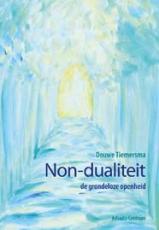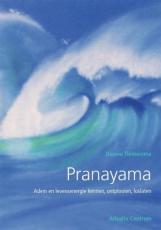Advaita Post 16-06 - On knowing
Advaita Post Volume 15 No. 6
Text Satsang
From an introduction and talk with Douwe Tiemersma, Gouda, May 22, 2002
On knowing
(Visitor) You say to steadily turn your attention back to its source within. When I look at that flower there, then the impulse is only directed out towards it.
(Douwe) That's the normal way of knowing.
And everything else that takes place internally distracts me from what's out there.
Yes, that's possible. Initially the withdrawal is necessary in order to become detached from what's out there. When the attention really turns back to its source first, then it creates what I've often referred to as an inside-out inversion. Then everything returns in a wonderful way. That occurs in a very different way than with the internal-external separation. Namely, there's no longer the old structure, "Me, here, the other things, there, and in between, the relation." This latter means a concentration of the attention, a fixation, a limiting and frequently also an obsession. It's important for all that to be thoroughly broken through. You see that the old form of knowing is so terribly limited, because it always begins from a particular 'I'. And that whole 'I' structure can become inflated. But what kind of knowing arises when this flower here actually enters completely within? The knowing then becomes more intimate than it ever could have been with the distancing kind of knowing. With it there's no separation any more between inside and outside, so that you, in a certain sense, are that flower. Everything is present in the realm of Self-being. That's a very different, intuitive kind of knowing. Traditionally, it is said of the liberated that they see themselves in everything that's visible. That's impossible when you continue to maintain this distance in your knowing. With this distance, you can observe the other, you can also analyze the other, you can pick it apart. So then the other is an object, in contrast to yourself as subject, as the source of the perceiving. But if just once, all that objectivity were to actually revert to the source of light in yourself, then suddenly everything would show itself to turn inside-out. Then there's no limitation in the self-being or its objects any more. Both completely merge into one another. Indeed, there certainly is a knowledge of this and that, but fundamentally, there is no separation any longer. That's advaita, non-separateness. It's not a positive unity, but non-separateness, about which you can't really say anything else. There is a direct knowing in your own sphere. And that knowing is unlimited.
When you start out from an 'objective' world and an 'objective' knowledge, you go around looking at and labeling everything, actually you want to rule out your subjectivity thereby. This is especially evident in the traditional sciences: if knowledge is to be objective, the subjectivity must be turned off through use of the scientific method. That this could be possible is a delusion. The subject always has a role to play. Why? Because there is no aloof perceiving and no perceived external world without a subject with its own starting point and method of perceiving. Consequently, knowledge is always conditioned. Truth remains a conditional truth.
But now, what is that subject? Traditionally, this is frequently asked in the texts of the ancient Upanishads: who is the actual perceiver? Now, just consider, not this, not that. When you truly realize something of the ultimate perceiver, then this whole structure of perceiver, perceived and perceiving turns out to not exist any more. Then it turns out that perceiving is a direct confirmation. Precisely because the phenomena are directly perceived phenomena, the perceiving of something is a given. The phenomena are there or they are not. When they are there, it turns out that they are there, as such. That is truth: the appearance of something.
When you start thinking and introduce all kinds of intermediate processes of perceiving, you say that perception is indirect. It makes use of different sense organs and all kinds of cognitive schemas. But if you start looking at perception just as it is present in yourself, then it is direct. Then it has nothing to do with eyes, brains and forms of knowing. There is a direct confirmation. Only when thinking jumps in, then you return to the disassembly, the indirectness. But, thinking is not perceiving.
Does your identifying with a person or a thing also belong to that direct knowing?
Yes of course. You don't have this direct experience only when you're involved in the advaita approach, rather, it's constantly there. You experience your identity directly with all kinds of people, especially the ones that are closer to you. If something happens to that other it also happens, more or less, to yourself. In communication, you often need only a word or two from the other in order to understand them. Yes, that is a direct knowing. Recognize that everywhere, even in the ordinary seeing of things.
Where does the perceiving take place? Not, like the neurobiologists say, in the brain. That's pure nonsense. When there is perception of a landscape, it has nothing to do with your brains and everything to do with the landscape. In the perception itself there is no brain, and if it is there, it's a brain, perceived as an object. Perception is direct: bam. Something appears here and now, in the light, and it's there. Even when a little later you look from the other side and you see something different. Even then, there is a direct perception in the here and now. Again and again there is a direct confirmation or there is not.
Yes, then in principle all is one. You can take any object ...
Yes, every object in perception comes intrinsically linked together with the subject, because otherwise there is no perception. In every instance of perceiving, there's actually a timeless moment, pang, and something is there. And that is a process in which the subject and object coincide. As subject you perceive something, and you perceive it as true, even though you may later establish that it was an inaccurate perception. Then there is namely, a new direct confirmation in your own sphere.
In the immediacy, the confirmation and the appearance coincide; consciousness and being, subject and object. Prior to their actual coincidence, there is an intuitive, internal perception, a being-knowing, in which you are no longer different from that which you perceive. When both poles completely coincide there is nothing more. Of this an empty being-knowing is still possible.
Er is geen tweeheid
als je ontspannen bent
in zelf-bewustzijn
is dat duidelijk.
Boeken
Douwe schreef en redigeerde gedurende zijn leven boeken. Via onze uitgeverij zijn deze nog verkrijgbaar.



